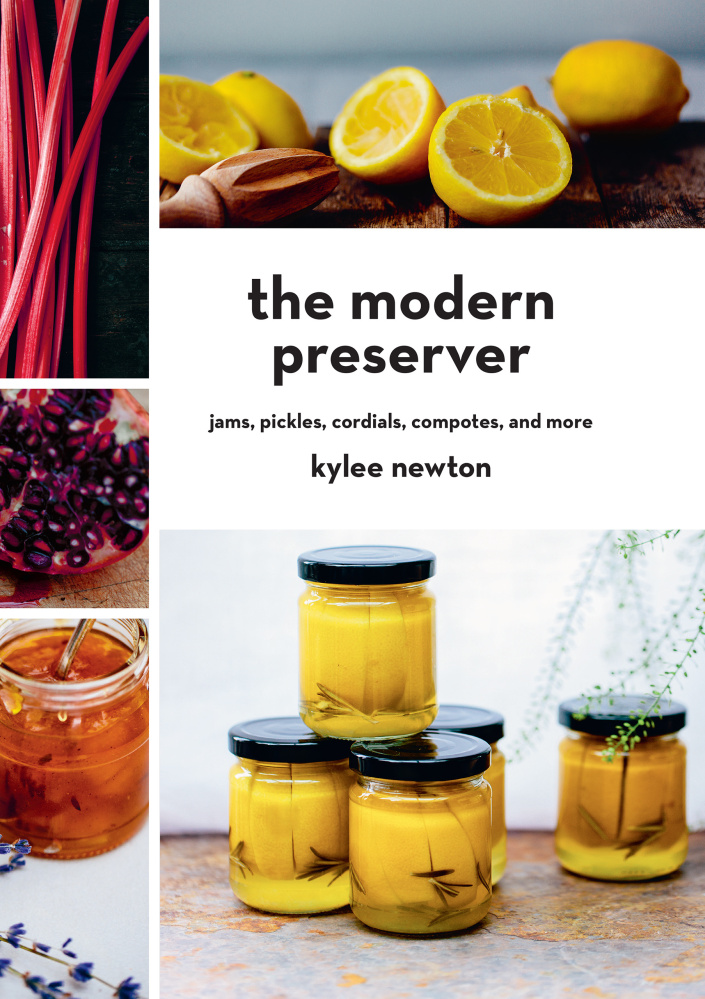“The Modern Preserver: Jams, Pickles, Cordials, Compotes and More.” By Kylee Newton. Countryman Press $25.95
Canning is not fun. With all of the attendant preparation, sterilization of jars and sweating over a simmering pot often in the height of summer, canning is labor.
What is fun is having canned, possessing the finished product, pretty jars sitting on a dark shelf as the temperature dips and scarcity replaces splendor, that satisfaction equivalent, as the “Joy of Cooking” puts it, “only to a clear conscience or a very becoming hat.”
“The Modern Preserver” by Kylee Newton presents a very different view. Here, canning is color and flash, preservation for an all-at-once age. A celebration not so much of capturing the seasons – Newton briefly describes the importance of using produce at its peak and wasting none of it – but of the alchemy of blending flavors to create something new and capturing that thing, like a sprite, in a jar with a vacuum seal.
Newton, a New Zealander who has lived for years in London, where she sells her homemade creations as Newton & Pott, encourages readers in the introduction to play with fruits and vegetables that are grown around the world and are now more accessible than ever.
“Let travel influence your ideas, spin that flavor wheel and try out new and interesting combinations,” she writes.
This is not your guide to canning local produce. Here recipes are offered for Beets and Orange Chutney, Roasted Pineapple and Coconut Sweet Pickle, Apple and Sage Butter, and Passionfruit Curd.
Yet, I did go to Newton’s book looking for ways to make the most of what’s ripe in my garden right now. Her recipe for homemade ketchup may be sedate, but it excited for me for its simplicity. She adds apples for sweetness, making this a perfect recipe for right now in New England, when local tomatoes and apples are abundant.
The bag of raspberries in my freezer are bound for Chocolate and Raspberry Jam. And I’ve earmarked Blueberries In a Pickle and Rhubarb and Prosecco Jelly, for when the seasons come around again. (Call me old-fashioned.)
Newton spends just two pages on sterilization and food safety. Her recipes generally recommend pouring hot contents into well-sterilized jars and sealing, without the extra step of processing the finished jars in boiling water or a pressure cooker. Lots of people have done it that way for many years, but the U.S. Department of Agriculture says that method isn’t enough to absolutely prevent botulism.
Use “Modern Preserver” for its many tantalizing recipes. For a guide to the basics of food preservation, try the “Joy of Cooking.”
HOMEMADE KETCHUP
Makes 4-5 17-ounce bottles
Newton writes that the key to thick ketchup is steeping the tomatoes in salt as long as possible, for at least three hours, and draining well. (I left them to steep overnight.) She recommends eating this with fish and chips, burgers (duh), or “anything else you like eating with ketchup.” Which, with this recipe, might be everything.
To make the spice bag, wrap the spices in a small piece of cheesecloth and secure with kitchen twine.
4 pounds tomatoes (preferably vine)
1 tablespoon salt
1 pound apples
1 pound onions
1 cup raw granulated sugar
11/4 cup distilled malt vinegar
1/4 teaspoon cayenne pepper
1 teaspoon ground allspice
SPICE BAG:
1 teaspoon black peppercorns
1 teaspoon whole cloves, lightly toasted
1 bay leaf
1/4 tsp chili flakes
Roughly chop the tomatoes, place in a large bowl and gently stir through with the salt. Leave to steep for at least 3 hours. If you don’t want tomato skins in your ketchup, blanch the tomatoes to remove the skins before chopping and salting.
Meanwhile, peel, core and dice the apples, and peel and roughly chop the onions.
Drain off the excess salted liquid from the tomatoes and prepare the spice bag. Put the tomatoes and spice bag, along with all the other ingredients, in a large, heavy-bottomed pan and bring to boil.
Simmer and stir steadily for 1 hour until the mixture has thickened and reduced by around a third.
Remove the spice bag and leave to cool then use a food processor or a food mill to blend the mixture to a smooth sauce-like consistency.
Return the sauce to the pan and bring to boil once again, simmering and stirring for another 20 minutes, skimming off any scum on the surface as it reduces.
Remove from the heat once it is as thick as you want it.
Using a funnel, ladle or pour the ketchup into warm, dry sterilized bottles.
Gently tap the bottom of the bottles on a hard surface to remove any air bubbles, then seal.
Can be eaten immediately but best left to mature for 2-4 weeks before opening.
Keeps for up to 6 months to a year unopened. Once opened, refrigerate and eat within 4 months.
Send questions/comments to the editors.



